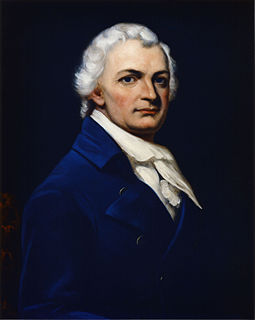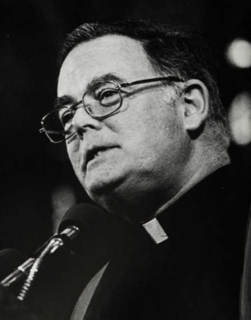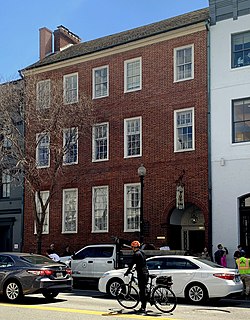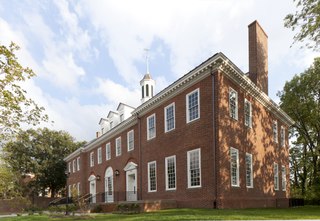
Georgetown is a historic neighborhood and commercial and entertainment district located in Northwest Washington, D.C., situated along the Potomac River. Founded in 1751 in the Province of Maryland, the port of Georgetown predated the establishment of the federal district and the City of Washington by 40 years. Georgetown remained a separate municipality until 1871 when the United States Congress created a new consolidated government for the whole District of Columbia. A separate act, passed in 1895, specifically repealed Georgetown's remaining local ordinances and renamed Georgetown's streets to conform with those in the City of Washington.

Benjamin Stoddert was the first United States Secretary of the Navy from 1 May 1798 to 31 March 1801.

James Hoban was an Irish-American architect, best known for designing the White House in Washington, D.C.

William Wilson Corcoran was an American banker, philanthropist, and art collector. He founded the Corcoran Gallery of Art.

Patrick Francis Healy was an American Catholic priest and Jesuit who was an influential president of Georgetown University, becoming known as its "second founder". The university's flagship building, Healy Hall, bears his name. Though he considered himself and was largely accepted as White, Healy was posthumously recognized as the first Black American to become a Jesuit, earn a PhD, and become the president of a predominantly White university.

The history of Washington, D.C., is tied to its role as the capital of the United States. Originally inhabited by an Algonquian-speaking people known as the Nacotchtank, the site of the District of Columbia along the Potomac River was first selected by President George Washington. The city came under attack during the War of 1812 in an episode known as the Burning of Washington. Upon the government's return to the capital, it had to manage the reconstruction of numerous public buildings, including the White House and the United States Capitol. The McMillan Plan of 1901 helped restore and beautify the downtown core area, including establishing the National Mall, along with numerous monuments and museums.

Timothy Stafford Healy was an American Catholic priest and Jesuit who straddled the religious and secular life, serving as the vice chancellor of the City University of New York, the president of Georgetown University, and the president of the New York Public Library.

Francis Ignatius Neale, also known as Francis Xavier Neale, was an American Catholic priest and Jesuit who led several academic and religious institutions in Washington, D.C. and Maryland. He played a substantial role in the Jesuit order's restoration in the United States.

The City Tavern Club is a private club in the Georgetown area of Washington, D.C., United States. It is housed in the City Tavern, one of the oldest buildings and the last remaining Federal-period tavern in the city.

The history of Georgetown University spans nearly four hundred years, from the early European settlement of America to the present day. Georgetown University has grown with both its city, Washington, D.C., and the United States, each of which date their founding to the period from 1788 to 1790. Georgetown's origins are in the establishment of the Maryland colony in the seventeenth century. Bishop John Carroll established the school at its present location by the Potomac River after the American Revolution allowed for free religious practice.

Wormley's Hotel was a five-story hotel at 1500 H Street, NW, Washington, D.C. It was opened in 1871. The hotel was owned by James Wormley, a free-born black man who had spent time in Europe learning fine culinary skills. The hotel became a hub for both local and foreign government officials. The hotel was the site of the Wormley Agreement, which led to the Compromise of 1877 and the election of President Rutherford B. Hayes. James Wormley died in 1884 and his son took over the business until he sold it in 1893. The hotel was later demolished and the Union Trust Company built on its site in 1906.
Columbian Harmony Cemetery was an African-American cemetery that formerly existed at 9th Street NE and Rhode Island Avenue NE in Washington, D.C., in the United States. Constructed in 1859, it was the successor to the smaller Harmoneon Cemetery in downtown Washington. All graves in the cemetery were moved to National Harmony Memorial Park in Landover, Maryland, in 1959. The cemetery site was sold to developers, and a portion used for the Rhode Island Avenue – Brentwood Washington Metro station.

St Patrick's Catholic Church is a Roman Catholic parish in Washington, District of Columbia, United States of America. Established in 1794, it is the oldest Catholic parish in the City of Washington.

William Matthews, occasionally spelled Mathews, was an American who became the fifth Roman Catholic priest ordained in the United States and the first such person born in British America. Born in the colonial Province of Maryland, he was briefly a novice in the Society of Jesus. After being ordained, he became influential in establishing Catholic parochial and educational institutions in Washington, D.C. He was the second pastor of St. Patrick's Church, serving for most of his life. He served as the sixth president of Georgetown College, later known as Georgetown University. Matthews acted as president of the Washington Catholic Seminary, which became Gonzaga College High School, and oversaw the continuity of the school during suppression by the church and financial insecurity.

Bernard A. Maguire was an Irish-American Catholic priest and Jesuit who served twice as the president of Georgetown University. Born in Ireland, he emigrated to the United States at the age of six, and his family settled in Maryland. Maguire attended Saint John's College in Frederick, Maryland, and then entered the Society of Jesus in 1837. He continued his studies at Georgetown University, where he also taught and was prefect, until his ordination to the priesthood in 1851.

James A. Ryder was an American Catholic priest and Jesuit who became the president of several Jesuit universities in the United States. Born in Ireland, he immigrated with his widowed mother to the United States as a child, to settle in Georgetown, in the District of Columbia. He enrolled at Georgetown College and then entered the Society of Jesus. Studying in Maryland and Rome, Ryder proved to be a talented student of theology and was made a professor. He returned to Georgetown College in 1829, where he was appointed to senior positions and founded the Philodemic Society, becoming its first president.

Charles Henry Stonestreet was an American Catholic priest and Jesuit who served in prominent religious and academic positions, including as provincial superior of the Jesuit Maryland Province and president of Georgetown University. He was born in Maryland and attended Georgetown University, where he co-founded the Philodemic Society. After entering the Society of Jesus and becoming a professor at Georgetown, he led St. John's Literary Institution and St. John the Evangelist Church in Frederick, Maryland. He was appointed president of Georgetown University in 1851, holding the office for two years, during which time he oversaw expansion of the university's library. The First Plenary Council of Baltimore was held at Georgetown during his tenure.

The Georgetown Neighborhood Library is a branch of the District of Columbia Public Library located in the Georgetown neighborhood of Washington, D.C. Established by an Act of Congress in 1934, the library houses the collection of its predecessor Peabody Library, which was founded in 1872 by a donation of George Peabody. The library opened in 1935 upon completion of the building, designed by Nathan C. Wyeth in the Colonial Revival style. It holds the only collection of materials in the public library system relating to Georgetown's history.
Enoch Fenwick was an American Catholic priest and Jesuit, who ministered throughout Maryland and became the president of Georgetown College. Descending from one of the original Catholic settlers of the British Maryland Province, he studied at Georgetown College in Washington, D.C. Like his brother and future bishop, Benedict Joseph Fenwick, he entered the priesthood, studying at St. Mary's Seminary, before entering the Society of Jesus, which was suppressed at the time. He was made rector of St. Peter's Pro-Cathedral in Baltimore by Archbishop John Carroll, and remained in the position for ten years. Near the end of his pastorate, he was also made vicar general of the Archdiocese of Baltimore, which involved traveling to say Mass in remote parishes throughout rural Maryland.

Jerome Daugherty was an American Catholic priest and Jesuit who served in many different capacities at Jesuit institutions throughout the northeast United States, eventually becoming president of Georgetown University in 1901. Born in Baltimore, he was educated at Loyola College in Maryland, before entering the Society of Jesus and becoming a member of the first class at Woodstock College. He then taught various subjects, including mathematics, Latin, Ancient Greek, rhetoric, and the humanities in Massachusetts, New York City, and Washington, D.C., and served as minister at many of the institutions there.



















